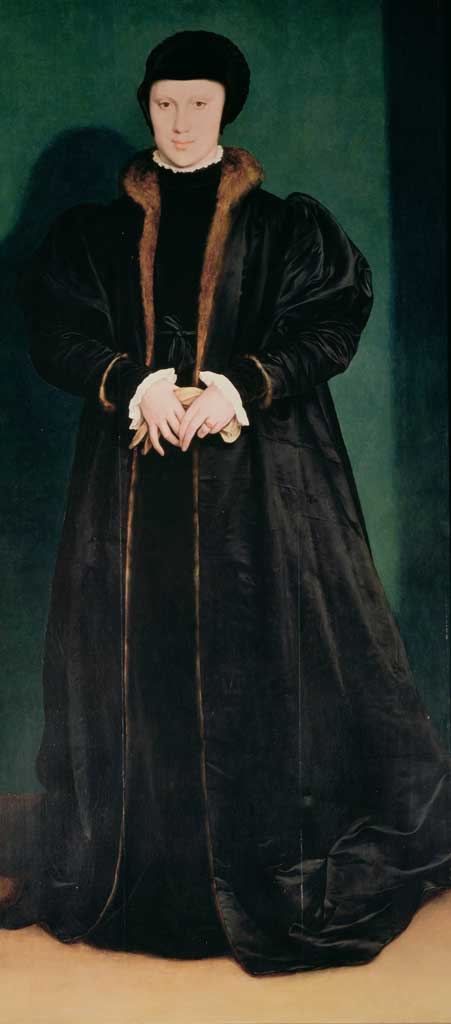Great Works: Christina of Denmark, Duchess of Milan, 1538 (119cm x 82 cm), Hans Holbein the Younger
National Gallery, London

In the spring of 1538, after the death of Jane Seymour, Henry VIII sent Hans Holbein to Brussels on an exploratory fishing expedition for future brides. Christina of Denmark, not so recently widowed, was a possible contender. He spent three hours in her presence – no more than that, according to the official records. He probably made a drawing – or even more than one. After his return to England, this was worked up into a full painting, which pleased Henry enormously, to such an extent that he was said to feel acute pleasure when in its presence. It was spirits-raising – a little like the prospect of the 2012 Olympics is said to be, if we are to believe the newspapers. In spite of Henry's positive response to Christina's likeness, there was no marriage. For all that, Henry liked the painting well enough to want to hang on to it – and the nation has hung on to it to this very day, although it nearly got sold off and spirited away to America early in the 20th century.
It is the only full-length portrait of a female that Holbein ever executed, and it seems to exude the spirit of humanism. It is more than merely a remarkable likeness. It seems to bring over the character of this young woman – she was just 16 years old when Holbein had his audience with her. Here she is, dressed in her opulent mourning clothes, attired in black satin, in a fur-trimmed coat which gives off that gorgeously characteristic satiny sheen. Look at that neatly tied bow at waist height. A bow ties a gift. She is a gift to any future king. Being floor-length, this coat, which is extraordinarily, mountainously contoured at its shoulders, would have susurrated gently as she walked, letting people know that her royal presence was in the offing.
How mobile, and how vitally alive, does this woman seem to be? Considerably. Holbein has deployed various tricks to make her appear so. Look at those gloves, for example, and how they seem to be twisted or twisting even as she holds them. The fingers look so writhingly active in their clutching. That helps to lend the portrait animation, the illusion of hand action at the very centre of the canvas. And then there are her lips, which may or may not be poised to open in order to give speech. Or perhaps she has just spoken. One or the other. Bernini would lend animation to some of his great portrait busts by doing something similar. Most of all, there is all this clever shadow play at her back which helps to push her forward into the king's (and our) presence; the shadow of the outline of her head and shoulders which looms like a dark wraith behind her right (our left) shoulder, and the vertical bar of shadow to her right which seems to define her physical presence, distancing her from the space, that rich green ground, against which she is standing. There is so much in that greenness. It is the greenness of nature, the greenness of the promise of warmth and fecundity, and much else too. This colour-field of green is also strangely bare of mark-making. We like that, though. Patterning of any kind would be a distraction from close observation of her person, which has not finished yet, not by any means.
There is human vitality, too, in the fact that she is slightly, pleasingly, breathingly irregular in all kinds of very small ways. She does not quite face directly forward, for example – that would be altogether too plastic for Holbein. No, her face is turned just a tad to the right (our left), which makes more of an expansive plain of her left cheek. Her eyebrows are not quite regular either. We see more of the left-hand side of her nose than of the right-hand side. Her positioning is not dead-centre on that canvas, either. That would be tedious. She is shifted slightly to the right (our left), and with the help of that vertical bar of shadow we are inclined to be persuaded to think that she just might be inclined to walk off to our left, and out of the picture altogether. All these devices individuate her, fire her.
But what we are itching to ask ever more corpulent Henry most of all is: how beautiful do you find this woman? We can accept that she is dignified, wholesome, and full of the promise of fecundity... But what of her flesh? We see little of it. Is she stout or not? Is she bonny? This was a mark of praise before Twiggy and, following in her wake, an as yet unquenched mania for the near skeletal took the world by storm. We really cannot tell. The contours of her body are not easily defined by the scrutinising eye of the onlooker. All we see is how richly she mourns.
ABOUT THE ARTIST
Hans Holbein the Younger (1497/8-1543) was one of the greatest European portraitists of the sixteenth or any other century. His drawings and paintings of members of the family and the Tudor court of Henry VIII are unsurpassed in their acute psychological insights and uncanny individuation. He also painted poets, merchants and tradesmen. Two of his greatest portraits are of Sir Thomas More and Erasmus. He also made paintings on religious themes, and was active as a designer for goldsmiths and jewellers.
Join our commenting forum
Join thought-provoking conversations, follow other Independent readers and see their replies
Comments